Prediction of Land Use and Land Cover Changes for North Sumatra, Indonesia, Using an Artificial-Neural-Network-Based Cellular Automaton
Abstract
:1. Introduction
2. Study Area and Data
2.1. North Sumatra
2.2. Data and Criteria
3. Methodology
3.1. Artificial-Neural-Network-Based Cellular Automaton Model
3.2. Validation
4. Results and Discussion
5. Conclusions
Author Contributions
Funding
Acknowledgments
Conflicts of Interest
References
- Anderson, J.R.; Hardy, E.E.; Roach, J.T.; Witmer, R.E. A Land Use and Land Cover Classification System for Use with Remote Sensor Data; United States Department of the Interior: Washington, DC, USA, 1983; p. 28. [Google Scholar]
- Li, X.; Yeh, A.G.-O. Neural-network-based cellular automata for simulating multiple land use changes using GIS. Int. J. Geogr. Inf. Sci. 2002, 16, 323–343. [Google Scholar] [CrossRef]
- Verburg, P.H.; Schot, P.P.; Dijst, M.J.; Veldkamp, A. Land use change modelling: Current practice and research priorities. GeoJournal 2004, 61, 309–324. [Google Scholar] [CrossRef]
- Mertens, B.; Lambin, E.F. Land-Cover-Change Trajectories in Southern Cameroon. Ann. Assoc. Am. Geogr. 2000, 90, 467–494. [Google Scholar] [CrossRef]
- Hathout, S. Land use change analysis and prediction of the suburban corridor of Winnipeg, Manitoba. J. Environ. Manag. 1988, 27, 325–335. [Google Scholar]
- White, R.; Engelen, G. Cellular Automata and Fractal Urban Form: A Cellular Modelling Approach to the Evolution of Urban Land-Use Patterns. Environ. Plan. A Econ. Space 1993, 25, 1175–1199. [Google Scholar] [CrossRef] [Green Version]
- Batty, M.; Xie, Y. From Cells to Cities. Environ. Plan. B Plan. Des. 1994, 21, S31–S48. [Google Scholar] [CrossRef]
- Wu, F. An Experiment on the Generic Polycentricity of Urban Growth in a Cellular Automatic City. Environ. Plan. B Plan. Des. 1998, 25, 731–752. [Google Scholar] [CrossRef]
- Clarke, K.C.; Gaydos, L.J. Loose-coupling a cellular automaton model and GIS: Long-term urban growth prediction for San Francisco and Washington/Baltimore. Int. J. Geogr. Inf. Sci. 1998, 12, 699–714. [Google Scholar]
- Veldkamp, A.; Fresco, L.O. CLUE-CR: An integrated multi-scale model to simulate land use change scenarios in Costa Rica. Ecol. Model. 1996, 91, 231–248. [Google Scholar] [CrossRef]
- Verburg, P.H.; Soepboer, W.; Veldkamp, A.; Limpiada, R.; Espaldon, V.; Mastura, S.S.A. Modeling the Spatial Dynamics of Regional Land Use: The CLUE-S Model. Environ. Manag. 2002, 30, 391–405. [Google Scholar] [CrossRef]
- Fischer, G.; Sun, L. Model based analysis of future land-use development in China. Agric. Ecosyst. Environ. 2001, 85, 163–176. [Google Scholar] [CrossRef]
- Bousquet, F.; Bakam, I.; Proton, H.; Le Page, C. Cormas: Common-Pool Resources and Multi-Agent Systems. In Tasks and Methods in Applied Artificial Intelligence; Pasqual del Pobil, A., Mira, J., Ali, M., Eds.; Springer: Berlin/Heidelberg, Germany, 1998; pp. 826–837. [Google Scholar]
- Rouchier, J.; Bousquet, F.; Requier-Desjardins, M.; Antona, M. A multi-agent model for describing transhumance in North Cameroon: Comparison of different rationality to develop a routine. J. Econ. Dyn. Control 2001, 25, 527–559. [Google Scholar] [CrossRef]
- Ren, Y.; Lü, Y.; Comber, A.; Fu, B.; Harris, P.; Wu, L. Spatially explicit simulation of land use/land cover changes: Current coverage and future prospects. Earth-Sci. Rev. 2019, 190, 398–415. [Google Scholar] [CrossRef]
- Liu, X.; Liang, X.; Li, X.; Xu, X.; Ou, J.; Chen, Y.; Li, S.; Wang, S.; Pei, F. A future land use simulation model (FLUS) for simulating multiple land use scenarios by coupling human and natural effects. Landsc. Urban Plan. 2017, 168, 94–116. [Google Scholar] [CrossRef]
- Batty, M.; Couclelis, H.; Eichen, M. Urban Systems as Cellular Automata. Environ. Plan. B Plan. Des. 1997, 24, 159–164. [Google Scholar] [CrossRef]
- Li, X.; Chen, Y.; Liu, X.; Li, D.; He, J. Concepts, methodologies, and tools of an integrated geographical simulation and optimization system. Int. J. Geogr. Inf. Sci. 2011, 25, 633–655. [Google Scholar] [CrossRef]
- Chen, Y.; Li, X.; Wang, S.; Liu, X. Defining agents’ behaviour based on urban economic theory to simulate complex urban residential dynamics. Int. J. Geogr. Inf. Sci. 2012, 26, 1155–1172. [Google Scholar] [CrossRef]
- Li, X.; Lin, J.; Chen, Y.; Liu, X.; Ai, B. Calibrating cellular automata based on landscape metrics by using genetic algorithms. Int. J. Geogr. Inf. Sci. 2013, 27, 594–613. [Google Scholar] [CrossRef]
- Liu, X.; Hu, G.; Ai, B.; Li, X.; Tian, G.; Chen, Y.; Li, S. Simulating urban dynamics in China using a gradient cellular automata model based on S-shaped curve evolution characteristics. Int. J. Geogr. Inf. Sci. 2018, 32, 73–101. [Google Scholar] [CrossRef]
- Liu, X.; Li, X.; Liu, L.; He, J.; Ai, B. A bottom-up approach to discover transition rules of cellular automata using ant intelligence. Int. J. Geogr. Inf. Sci. 2008, 22, 1247–1269. [Google Scholar] [CrossRef]
- Liu, X.; Li, X.; Shi, X.; Wu, S.; Liu, T. Simulating complex urban development using kernel-based non-linear cellular automata. Ecol. Model. 2008, 211, 169–181. [Google Scholar] [CrossRef]
- Gustafson, E.J.; Shifley, S.R.; Mladenoff, D.J.; Nimerfro, K.K.; He, H.S. Spatial simulation of forest succession and timber harvesting using LANDIS. Can. J. For. Res. 2000, 30, 32–43. [Google Scholar] [CrossRef]
- Kok, K.; Winograd, M. Modelling land-use change for Central America, with special reference to the impact of hurricane Mitch. Ecol. Model. 2002, 149, 53–69. [Google Scholar] [CrossRef]
- Li, X.; Chen, G.; Liu, X.; Liang, X.; Wang, S.; Chen, Y.; Pei, F.; Xu, X. A New Global Land-Use and Land-Cover Change Product at a 1-km Resolution for 2010 to 2100 Based on Human-Environment Interactions. Ann. Am. Assoc. Geogr. 2017, 107, 1040–1059. [Google Scholar] [CrossRef]
- D’Aquino, P.; August, P.; Balmann, A.; Berger, T.; Bousquet, F.; Brondízio, E.; Brown, D.G.; Couclelis, H.; Deadman, P.; Goodchild, M.F.; et al. Agent-Based Models of Land-Use and Land-Cover Change. In LUCC Report Series; Parker, D.C., Berger, T., Manson, S.M., Eds.; LUCC International Project Office: Barcelona, Spain, 2001; Volume 6, p. 140. [Google Scholar]
- Liping, C.; Yujun, S.; Saeed, S. Monitoring and predicting land use and land cover changes using remote sensing and GIS techniques—A case study of a hilly area, Jiangle, China. PLoS ONE 2018, 13, e0200493. [Google Scholar] [CrossRef]
- Lubis, J.P.G.; Nakagoshi, N. Land Use and Land Cover Change Detection using Remote Sensing and Geographic Information System in Bodri Watershed, Central Java, Indonesia. J. Int. Dev. Coop. 2011, 18, 139–151. [Google Scholar]
- Suharsono, P.; Danoedoro, P. Pemetaan Ekologi Bentanglahan Sumatera Utara Berdasarkan Citra Satelit LANDSAT Enhanced Thematic Mapper Plus (ETM+). In Dari Pengolahan Dan Analisis Citra Hingga Pemetaan Dan Pemodelan Spasial; Gadjah Mada University: Yogyakarta, Indonesian, 2004. [Google Scholar]
- Kailola, E.A. Status Lingkungan Hidup Daerah Provinsi Sumatera Utara Tahun. In Badan Lingkungan Hidup Provinsi Sumatera Utara; North Sumatra Living Environment Agency: Medan, Indonesia, 2015. [Google Scholar]
- Hutagalung, F. Persepsi Masyarakat di Sekitar Danau Toba Terkait Rendahnya Tingkat Keberhasilan Reboisasi di Daerah Tangkapan Air Danau Toba. Peronema For. Sci. J. 2014, 4, 115–119. [Google Scholar]
- Ambarita, E.C.; Sitorus, M.S.H. Modal Sosial Komunitas Petani Kemenyan Dalam Pelestarian Hutan Kemenyan Di Desa Pandumaan, Kecamatan Pollung, Kabupaten Humbang Hasundutan. Perspektif Sosiologi 2015, 3, 42–57. [Google Scholar]
- Jayusman. Mengenal Pohon Kemenyan (Styrax spp.); IPB Press: Jakarta, Indonesia, 2014. [Google Scholar]
- Pinem, D.E.; Sianipar, B.B. Purnama Kajian Alokasi Kebutuhan Ruang di Provinsi Sumatera Utara. Jurnal Wilayah Dan Lingkungan 2015, 3, 203–228. [Google Scholar] [CrossRef]
- Omar, N.Q.; Sanusi, S.A.M.; Hussin, W.M.W.; Samat, N.; Mohammed, K.S. Markov-CA model using analytical hierarchy process and multiregression technique. In IOP Conference Series: Earth and Environmental Science; IOP: London, UK, 2014; Volume 20, p. 012008. [Google Scholar]
- Rwanga, S.S.; Ndambuki, J.M. Accuracy Assessment of Land Use/Land Cover Classification Using Remote Sensing and GIS. Int. J. Geosci. 2017, 8, 611–622. [Google Scholar] [CrossRef] [Green Version]
- Sim, J.; Wright, C.C. The Kappa Statistic in Reliability Studies: Use, Interpretation, and Sample Size Requirements. Phys. Ther. 2005, 85, 257–268. [Google Scholar] [Green Version]
- Landis, J.R.; Koch, G.G. The Measurement of Observer Agreement for Categorical Data. Biometrics 1977, 33, 159–174. [Google Scholar] [CrossRef]
- Daulay, A.R.; Eka Intan, K.P.; Barus, B.; Pramudya, N.B. Rice Land Conversion into Plantation Crop and Challenges on Sustainable Land Use System in the East Tanjung Jabung Regency. Procedia Soc. Behav. Sci. 2016, 227, 174–180. [Google Scholar] [CrossRef] [Green Version]
- Setiawan, Y.; Lubis, M.I.; Yusuf, S.M.; Prasetyo, L.B. Identifying Change Trajectory over the Sumatra’s Forestlands Using Moderate Image Resolution Imagery. Procedia Environ. Sci. 2015, 24, 189–198. [Google Scholar] [CrossRef]
- Hutagalung, F.; Utomo, B.; Dalimunthe, A. Public Perception in The Vicinity of Low Level Related Toba Lake Success Reforestation in The Catchment Area Lake Toba. Peronema For. Sci. J. 2014, 4, 115–119. [Google Scholar]
- Cabrera, J.; Lee, H. Impacts of Climate Change on Flood-Prone Areas in Davao Oriental, Philippines. Water 2018, 10, 893. [Google Scholar] [CrossRef]
- Khattiyavong, C.; Lee, H.S. Performance Simulation and Assessment of an Appropriate Wastewater Treatment Technology in a Densely Populated Growing City in a Developing Country: A Case Study in Vientiane, Laos. Water 2019, 11, 1012. [Google Scholar] [CrossRef]
- Bakker, M.M.; Govers, G.; Kosmas, C.; Vanacker, V.; Oost, K.V.; Rounsevell, M. Soil erosion as a driver of land-use change. Agric. Ecosyst. Environ. 2005, 105, 467–481. [Google Scholar] [CrossRef]
- Geist, H.J.; Lambin, E.F. Dynamic Causal Patterns of Desertification. BioScience 2004, 54, 817–829. [Google Scholar] [CrossRef]
- Sohl, T.L.; Sayler, K.L.; Drummond, M.A.; Loveland, T.R. The FORE-SCE model: A practical approach for projecting land cover change using scenario-based modeling. J. Land Use Sci. 2007, 2, 103–126. [Google Scholar] [CrossRef]
- Xiang, W.-N.; Clarke, K.C. The Use of Scenarios in Land-Use Planning. Environ. Plan. B Plan. Des. 2003, 30, 885–909. [Google Scholar] [CrossRef] [Green Version]
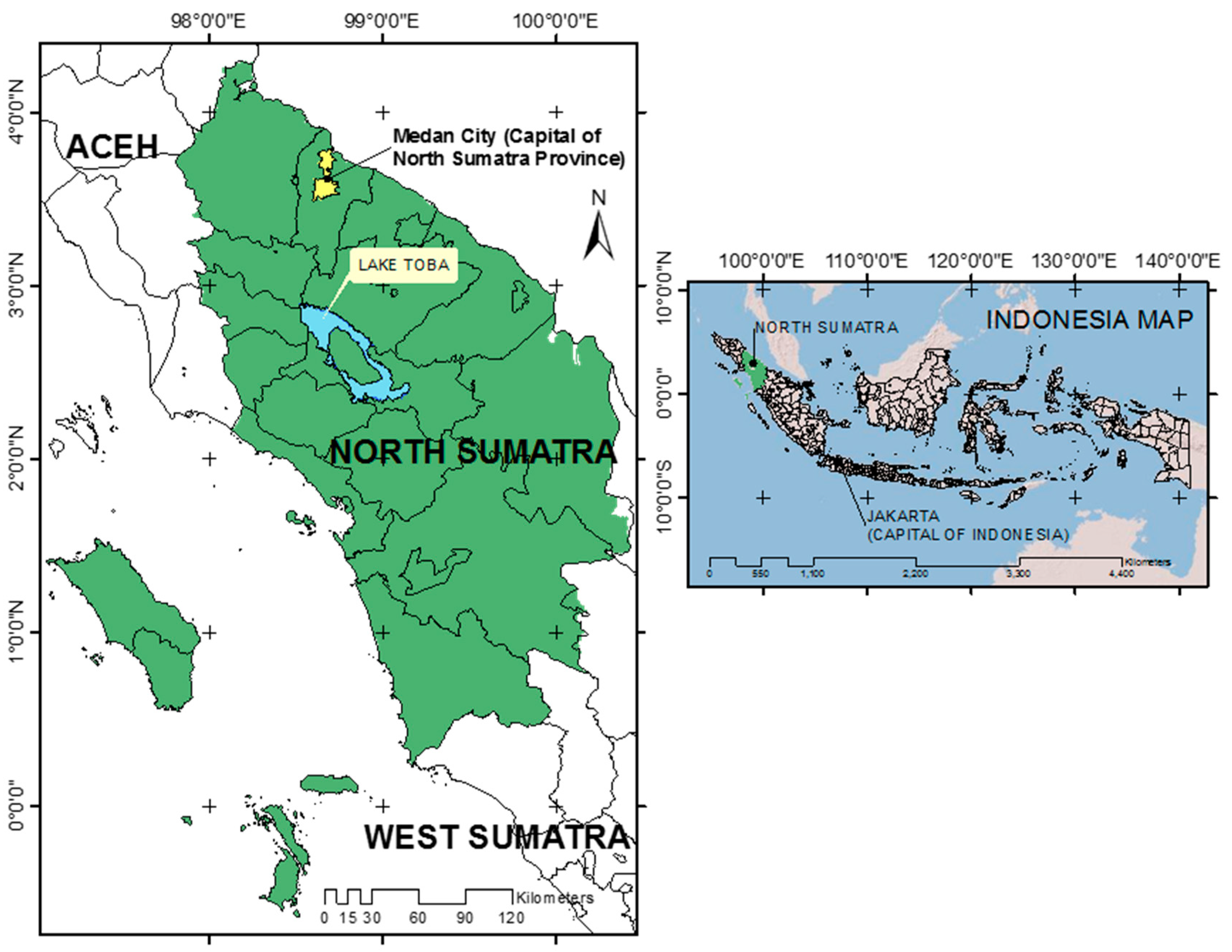
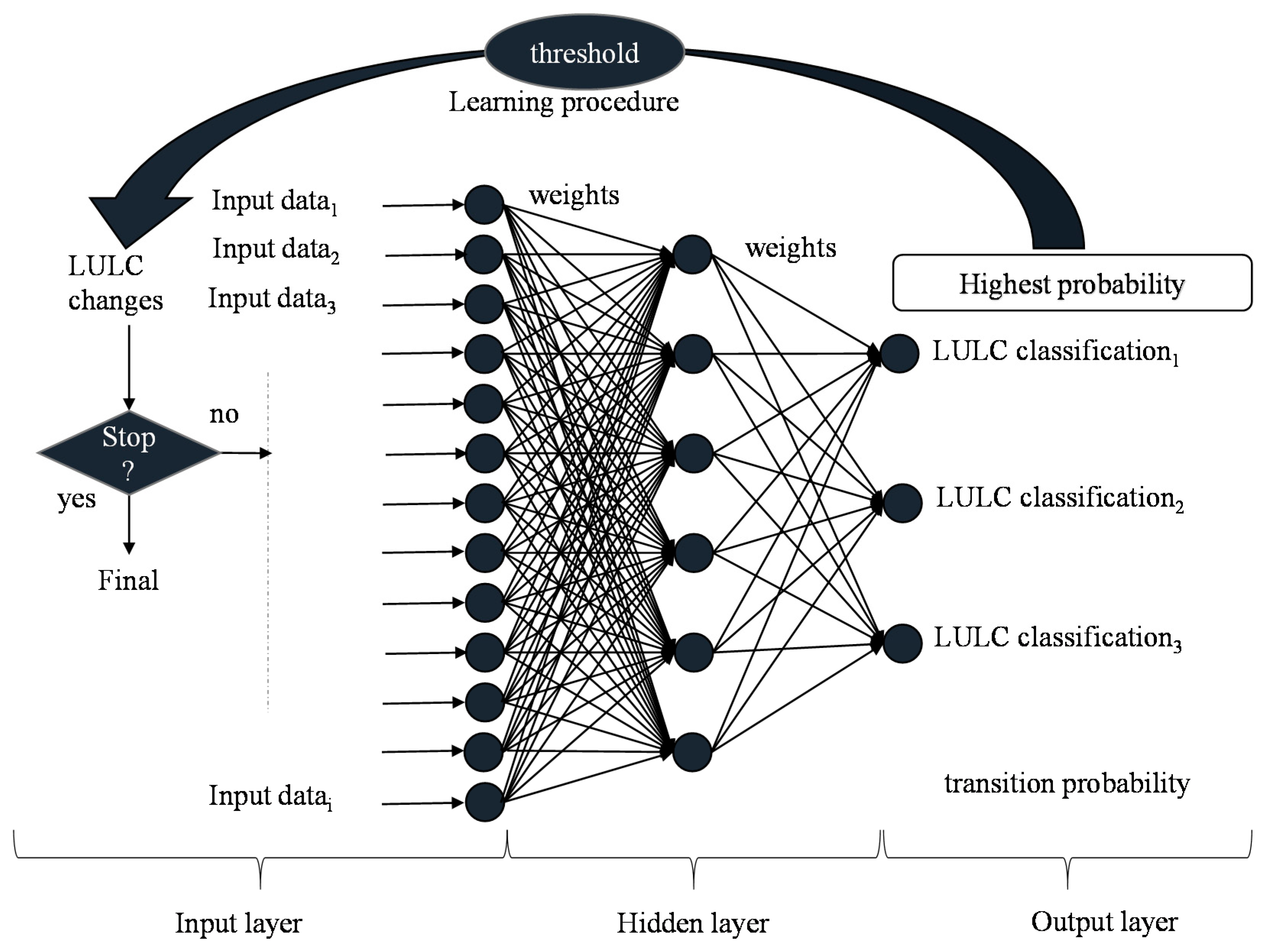
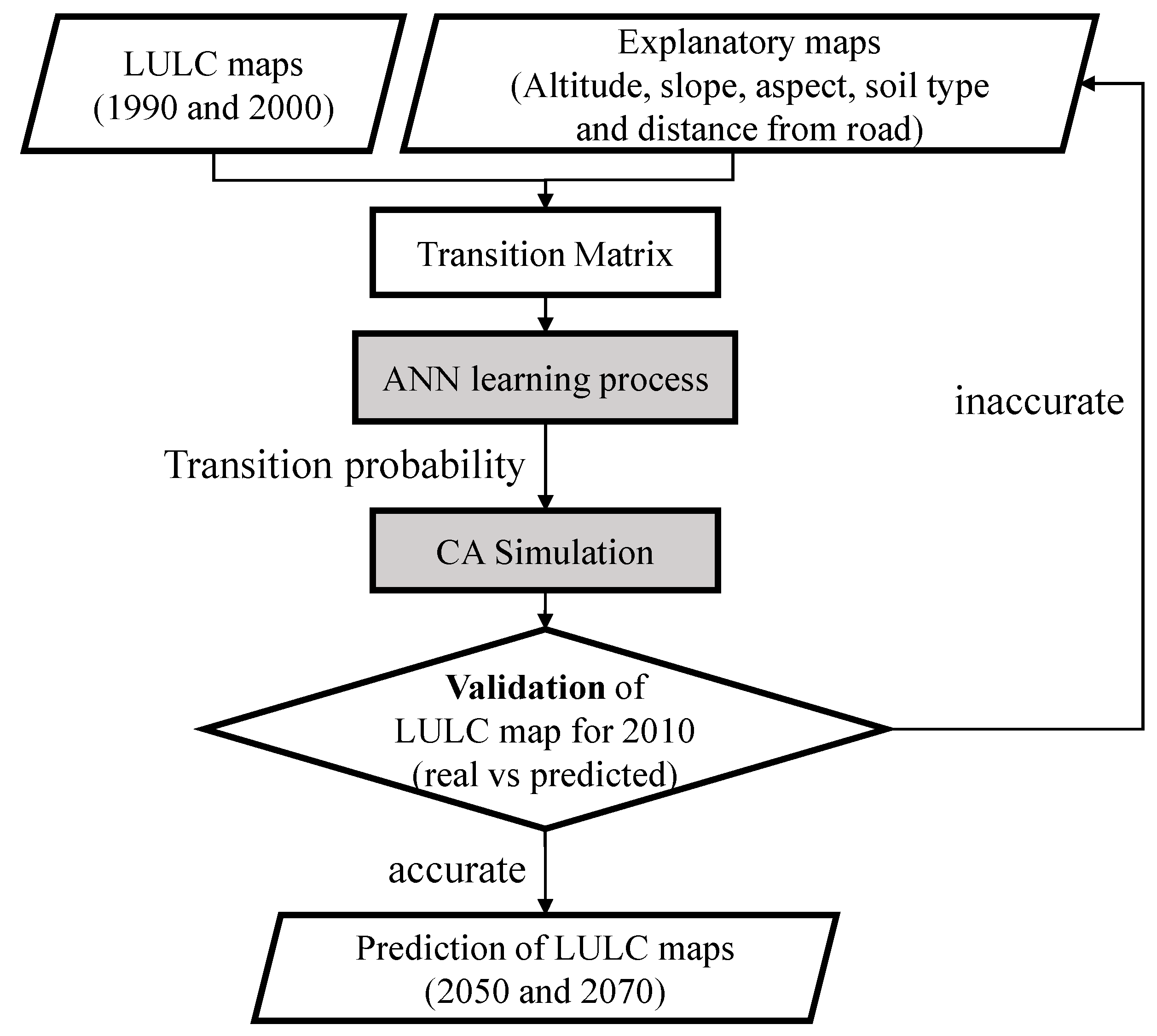
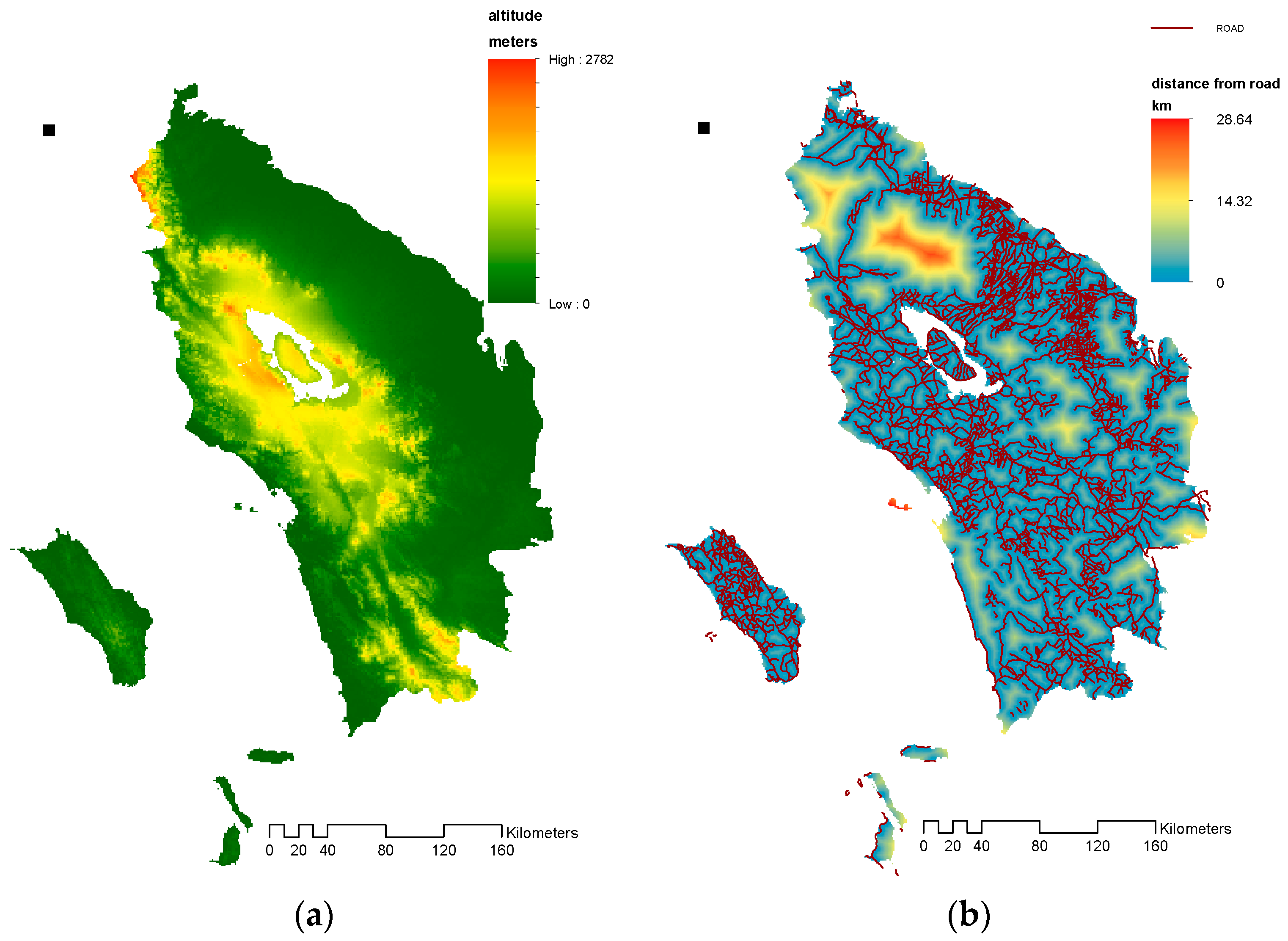
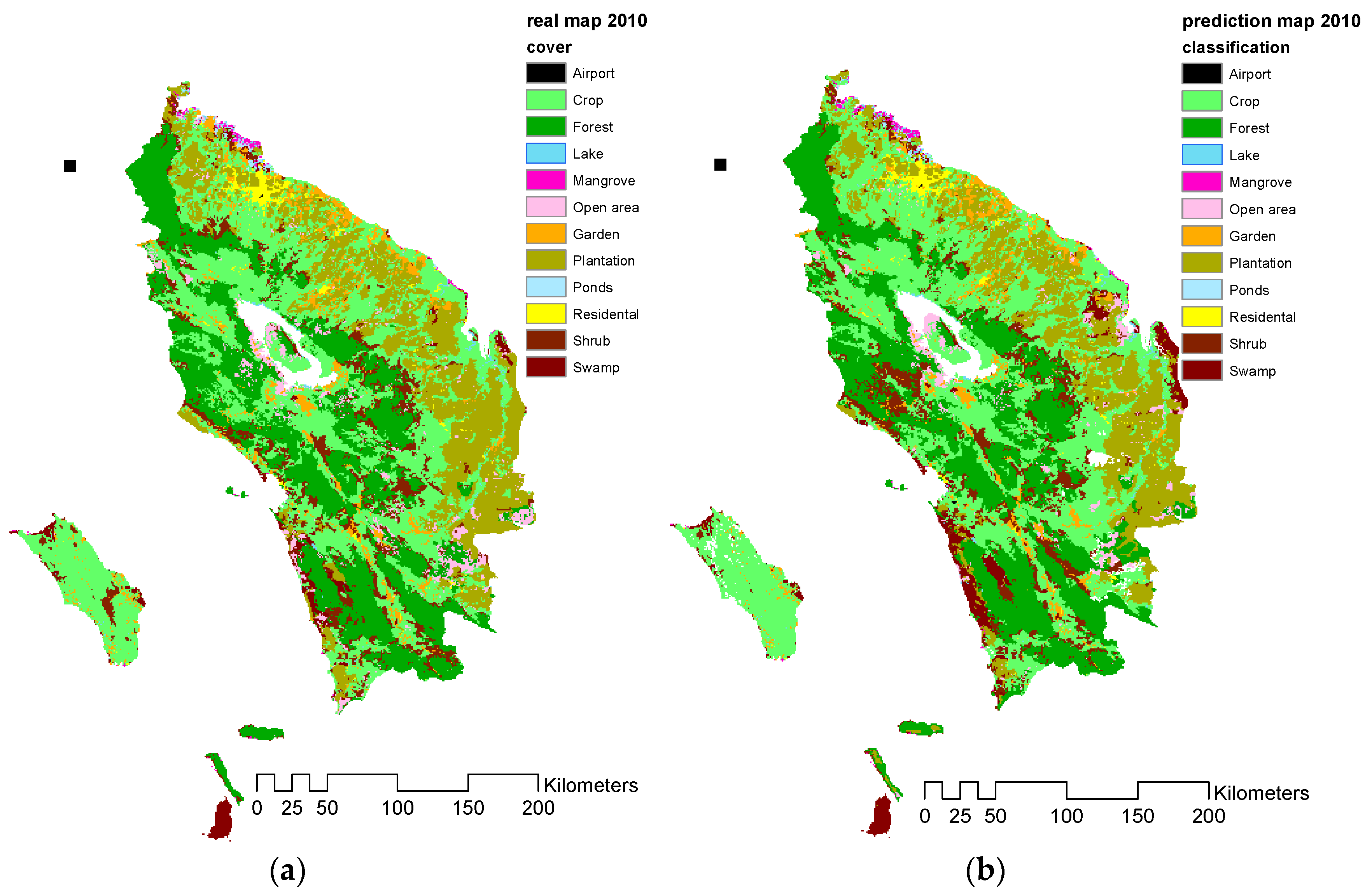
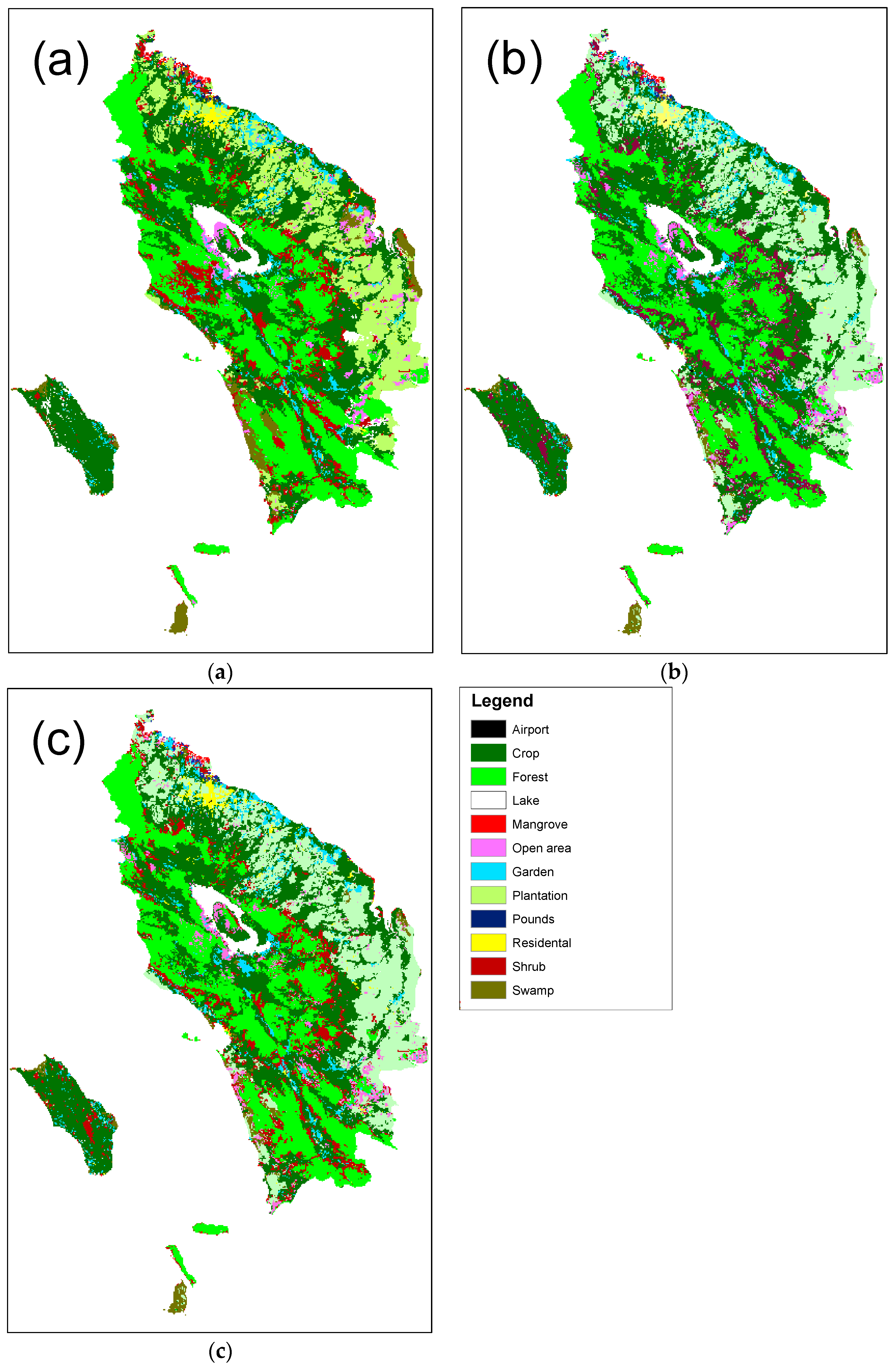
| Data | Criteria | LULC Simulation | Year | Description | Source | Data Format |
|---|---|---|---|---|---|---|
| DEM | Altitude | Exploratory map | 2017 | ASTER GDEM with 30 arc-sec spatial resolution | United State Geological Survey (USGS) (https://earthexplorer.usgs.gov/) | GeoTIFF |
| Slope | Exploratory map | |||||
| Aspect | Exploratory map | |||||
| Road map | Distance from the road | Exploratory map | 2000 | The main road map of North Sumatra | Ministry of Environment and Forestry, Indonesia | shp |
| Soil type | Soil type | Exploratory map | 2000 | A spatial soil type inventory (30 arc seconds) for year 2000 | Food and Agriculture Organization (FAO) (http://www.fao.org/soils-portal/soil-survey/soil-maps-and-databases/harmonized-world-soil-database-v12/en/) | TIFF |
| LULC map | LULC | Input map | 1990 | A satellite image from Landsat, USGS and LAPAN | Ministry of Environment and Forestry, Indonesia (http://webgis.dephut.go.id:8080/kemenhut/index.php/id/fitur/unduhan) | KML |
| 2000 | ||||||
| 2010 |
| No | Classification | Description |
|---|---|---|
| 1 | Airport | The built area for transportation |
| 2 | Crop | The area for crop plants alone and with shrub plants |
| 3 | Forest | The area of primary, secondary and plantation forest |
| 4 | Lake | The area of large-scale water bodies |
| 5 | Mangrove | The area for primary and secondary mangrove forest |
| 6 | Open area | The barren area |
| 7 | Garden field | The area with square and near human settlement |
| 8 | Plantation | The area dominated by oil palm and rubber plant |
| 9 | Pond | The area of small-scale water bodies for fisheries |
| 10 | Residential | Transmigration and permanent residential area |
| 11 | Shrub | Shrub and juvenile plant area |
| 12 | Swamp | Primary and secondary swamp forest area |
| No | Criteria/Combination | % of Correctness | Kappa |
|---|---|---|---|
| 1 | Alt, road, urban | 86.59 | 0.83 |
| 2 | Alt, urban | 87.48 | 0.83 |
| 3 | Alt, road | 87.82 | 0.83 |
| 4 | Urban, road, | 85.8 | 0.81 |
| 5 | Alt, urban, road, soil type, aspect | 86.85 | 0.82 |
| 6 | Alt, urban, road, soil type, slope, aspect | 87.4 | 0.83 |
| 7 | Aspect, urban, slope | 87.28 | 0.83 |
| Classification | 2000 | Sum | ||||||||||||
|---|---|---|---|---|---|---|---|---|---|---|---|---|---|---|
| Airport | Crop | Forest | Lake | Mangrove | Open Area | Garden | Plantation | Pond | Residential | Shrub | Swamp | |||
| 1990 | Airport | 1 | 0 | 0 | 0 | 0 | 0 | 0 | 0 | 0 | 0 | 0 | 0 | 1 |
| Crop | 0 | 0.96143 | 0.00046 | 0 | 0 | 0.00210 | 0.00631 | 0.02882 | 0.00018 | 0.00063 | 0.00004 | 0.00004 | 1 | |
| Forest | 0 | 0.00908 | 0.92400 | 0 | 0 | 0.01547 | 0.00013 | 0.04580 | 0 | 0 | 0.00493 | 0.00060 | 1 | |
| Lake | 0 | 0.00252 | 0 | 0.99748 | 0 | 0 | 0 | 0 | 0 | 0 | 0 | 0 | 1 | |
| Mangrove | 0 | 0.00521 | 0 | 0 | 0.81250 | 0.04167 | 0 | 0.00521 | 0.11458 | 0 | 0 | 0.02083 | 1 | |
| Open Area | 0 | 0.00417 | 0 | 0 | 0.00139 | 0.97153 | 0 | 0.02292 | 0 | 0 | 0 | 0 | 1 | |
| Garden | 0 | 0.02036 | 0 | 0 | 0 | 0.00750 | 0.93283 | 0.03108 | 0 | 0.00822 | 0 | 0 | 1 | |
| Plantation | 0 | 0.09766 | 0 | 0 | 0 | 0.01163 | 0 | 0.88856 | 0.00017 | 0.00009 | 0.00190 | 0 | 1 | |
| Pond | 0 | 0 | 0 | 0 | 0 | 0 | 0 | 0 | 1 | 0 | 0 | 0 | 1 | |
| Residential | 0 | 0 | 0 | 0 | 0 | 0 | 0.00571 | 0 | 0 | 0.99429 | 0 | 0 | 1 | |
| Shrub | 0 | 0.11184 | 0.00144 | 0 | 0 | 0.00497 | 0 | 0.05318 | 0 | 0 | 0.82833 | 0.00026 | 1 | |
| Swamp | 0 | 0.03147 | 0.00305 | 0 | 0.00025 | 0.05279 | 0.00685 | 0.15685 | 0.00812 | 0 | 0.03325 | 0.70736 | 1 | |
| Sum | 1.0 | 1.24374 | 0.92894 | 0.99748 | 0.81414 | 1.10765 | 0.95184 | 1.23242 | 1.12305 | 1.00322 | 0.86843 | 0.72909 | 12.0 | |
| Classification | LULC Change Ratio | ||
|---|---|---|---|
| The Predicted (2010)–The Real (2010) | The Predicted (2010)–The Real (2000) | The Real (2010)–The Real (2000) | |
| Airport | 0.0001 | 0.0000 | −0.0001 |
| Crop | 1.1763 | 0.1986 | −0.9777 |
| Forest | 0.9279 | −0.5885 | −1.5164 |
| Lake | −0.0133 | −0.0173 | −0.0040 |
| Mangrove | 0.0740 | −0.0222 | −0.0962 |
| Open area | −0.8128 | −0.2665 | 0.5464 |
| Garden | −0.6965 | −0.0864 | 0.6102 |
| Plantation | −1.8071 | 1.1732 | 2.9804 |
| Ponds | −0.0438 | −0.0234 | 0.0203 |
| Residential | −0.0621 | −0.0456 | 0.0165 |
| Shrub | −0.2222 | −0.1752 | 0.0471 |
| Swamp | 1.4796 | −0.1468 | −1.6264 |
| Classifications | LULC Changes (%) | ||||
|---|---|---|---|---|---|
| 2070–2050 | 2070–2000 | 2050–2000 | 2000–1990 | 2010–2000 | |
| Airport | 0.0000 | −0.0001 | −0.0001 | 0.0001 | −0.0001 |
| Crop | −0.0012 | −1.2860 | −1.2848 | 1.3730 | −0.9777 |
| Forest | −0.0477 | −1.7256 | −1.6779 | −1.9777 | −1.5164 |
| Lake | 0.0000 | −0.0444 | −0.0444 | 0.0023 | −0.0040 |
| Mangrove | 0.0000 | −0.1084 | −0.1084 | −0.0817 | −0.0962 |
| Open area | −0.0098 | 0.3616 | 0.3714 | 0.9826 | 0.5464 |
| Garden field | 0.0073 | 0.3606 | 0.3532 | 0.0485 | 0.6102 |
| Plantation | 0.0330 | 4.1709 | 4.1379 | 2.1559 | 2.9804 |
| Pond | 0.0000 | 0.0081 | 0.0081 | 0.1031 | 0.0203 |
| Residential | −0.0012 | −0.1218 | −0.1206 | 0.0534 | 0.0165 |
| Shrub | 0.0220 | 0.1768 | 0.1547 | −1.2761 | 0.0471 |
| Swamp | −0.0024 | −1.7916 | −1.7891 | −1.3834 | −1.6264 |
© 2019 by the authors. Licensee MDPI, Basel, Switzerland. This article is an open access article distributed under the terms and conditions of the Creative Commons Attribution (CC BY) license (http://creativecommons.org/licenses/by/4.0/).
Share and Cite
Saputra, M.H.; Lee, H.S. Prediction of Land Use and Land Cover Changes for North Sumatra, Indonesia, Using an Artificial-Neural-Network-Based Cellular Automaton. Sustainability 2019, 11, 3024. https://doi.org/10.3390/su11113024
Saputra MH, Lee HS. Prediction of Land Use and Land Cover Changes for North Sumatra, Indonesia, Using an Artificial-Neural-Network-Based Cellular Automaton. Sustainability. 2019; 11(11):3024. https://doi.org/10.3390/su11113024
Chicago/Turabian StyleSaputra, Muhammad Hadi, and Han Soo Lee. 2019. "Prediction of Land Use and Land Cover Changes for North Sumatra, Indonesia, Using an Artificial-Neural-Network-Based Cellular Automaton" Sustainability 11, no. 11: 3024. https://doi.org/10.3390/su11113024






